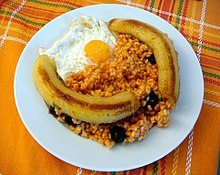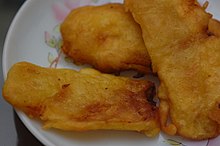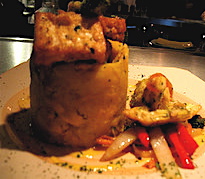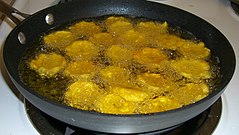Plantain dishes
Main article: List of banana dishes
Main article: AlcapurriaAlcapurria
Alcapurria is a type of savory Puerto Rican fritter. Although usually consisting mainly of grated green bananas and yautias, they can also contain plantains. The masa (dough) is used to encase a filling of ground meat (picadillo), and the alcapurrias are then deep-fried.
Aloco
Plantains are used in the Ivory Coast dish aloco as the main ingredient. Fried plantains are covered in an onion-tomato sauce, often with a grilled fish between the plantains and sauce.[28]
Arañitas
"Little spiders" in Spanish translation, a Puerto Rican pattie fritter made from shredded unripe plantains mixed with cilantro, garlic, salt and some recipes with egg.
Ash plantains
Sri Lanka's ash plantains called alu kesel are generally used for cooking. On some occasions, they are used in Ayurvedic medicine. Plantain flower also called as kesel mala (or kehelmala or kesel muwa). Plantain flower (or kehelmala or kesel muwa) is also used to make curries to be eaten with rice.
Banana cue, Turrón and Arroz a la Cuba
In the Philippines, Banana cue is a popular snack. The portmanteau 'Banana cue' may be a misnomer as it is not really cooked in a skewer over hot embers like a barbecue. Rather, the peeled flesh of an under ripe plantain is fried in hot oil over medium fire before it is held in a skewer ready for sale. There are two ways to prepare a banana cue. One way is to fry the peeled banana in oil with some amount of brown sugar thrown in to caramelize the flesh. Another way is to fry the flesh in oil until done. When done, they are scooped out of the cooking pan and placed on a dripping pan to allow the oil to drip, before a generous amount of refined sugar is sprinkled over them. A variant from Mindanao, known as Ginanggang, is different in that it is actually grilled over charcoal.
Philippine plantains (called Saba or Cardaba Bananas) are much smaller than the Latin American varieties, usually around 4–5 inches and somewhat boxy in shape. They are eaten mostly in their ripe stage as a dessert or sweet snack, often simply boiled, in syrup, or sliced lengthwise and fried, then sprinkled with sugar. They are also quite popular in this fried form (without the sugar) in the local version of the Spanish dish, Arroz a la Cubana, consisting of minced picadillo-style seasoned beef, white rice, and fried eggs, with fried plantains on the side. In addition, there is the equally popular merienda snack, Turrón, where ripe plantains are sliced and then wrapped in lumpia wrapper (a thin rice paper) and deep-fried. Turron is then finished off with a brown sugar glaze.
The traditional South American style large plantains (grown in the Southern Philippines) are now increasingly available in local Filipino markets.
Bolle
Bolle is the term used for roasted plantain in Nigeria. The plantain is usually grilled and served with roasted fish, ground peanuts and a hot palm oil sauce. It is very popular as a lunch snack in southern and western Nigeria, for example in Rivers State, Cross River State, Delta State and Lagos State. It is popular among the working class as a quick midday meal.
Bolitas de Platano
Plantain dumplings from Puerto Rico are grated and mixed with cornstarch, egg, seasoning, parsley, and annatto oil. They are then formed into a ball about the size of a golf ball. The balls are first deep fried and then dropped into a hot broth usually a soup with pigeon peas and ham called asopao.
Cayeye
Main article: Cayeye
Cayeye, also called Mote de Guineo, is a traditional Colombian dish from the Caribbean Coast of the country. Cayeye is made by cooking small green bananas or plantains in water, then mashing and mixing them with refrito, made with onions, garlic, red bell pepper, tomato and achiote.
Cayeye are usually served for breakfast with fresh grated Colombian cheese (Queso Costeño) and fried fish, shrimp, crab, or beef. Most popular is Cayeye with fresh cheese, avocado and fried egg on top.
Chifles
Main article: chifle
Chifles is the Spanish term used in Peru and Ecuador for fried green plantains sliced (1 or 2 mm thick); it is also used to describe plantain chips which are sliced thinner.
Dodo
Plantain is popular in West Africa, especially Cameroon, Bénin, Ghana and Nigeria; when ripe plantain is fried, it is generally called dodo (dough – dough). The ripe plantain is usually sliced diagonally for a large oval shape, then fried in oil to a golden brown color. This can be eaten as such, with stew or served with beans or on rice.
In Ikire, a town in Western Nigeria precisely Osun State, there is a special and unique way of preparing plantain chips. This is popularly called Dodo Ikire. Dodo Ikire is made from overripe plantain, chopped in small pieces, sprinkled with chili pepper and fried in boiling point palm oil. After frying it turns blackish. The fried plantain chips are then stuffed carefully into a special conically shaped woven basket of about 10 centimeters high. This special dodo can have a preservative quality that lasts up to two months without refrigeration.
Ethakka appam
Ethakka appam, pazham (banana) boli or pazham pori are terms used for fried plantain in Kerala. The plantain is usually dipped in sweetened rice and white flour batter and then fried in coconut or vegetable oil. It is a very popular snack among Keralites. This is very similar to pisang goreng (Indonesian for fried bananas), which is a dessert common to Malaysia, Indonesia and Singapore.
Fufu de platano
Fufu de platano is a traditional and very popular lunch dish in Cuba, and essentially akin to the Puerto Rican mofongo. It is a fufu made by boiling the plantains in water and mashing with a fork. The fufu is then mixed with chicken stock and sofrito, a sauce made from lard, garlic, onions, pepper, tomato sauce, a touch of vinegar and cumin. The texture of Cuban fufu is similar to the mofongo consumed in Puerto Rico, but it is not formed into a ball. Fufu is also a common centuries-old traditional dish made in Côte d'Ivoire, Ghana, Nigeria, Cameroon and other West & Central African countries. It is made in a similar fashion as the Cuban fufu, but is pounded, and has a thick paste, putty-like texture which is then formed into a ball. West African fufu is sometimes separately made with cassava, yams or made with plantains combined with cassava.
Majado, tigrillo, and bolones
In Ecuador, plantain is boiled, crushed, scrambled, and fried into majado. This dish is typically served with a cup of coffee and bistek, fish, or grated cheese. It is a popular breakfast dish. Majado is also used as a base to prepare tigrillo and bolones. To prepare trigrillo, majado is scrambled with pork rind, egg, cheese, green onions, parsley, and cilantro. To prepare bolones, majado is scrambled with cheese, pork rind, or a mixture of both. The resulting mixture is then shaped into a sphere which is later deep-fried. Both tigrillo and bolones are typically served with a cup of coffee.
Mangú
Main article: Mangú (dish)
A traditional mangú from the Dominican Republic consists of peeled green, boiled plantains, mashed with enough hot water they were boiled in so the consistency is a little stiffer than mashed potatoes. It is traditionally eaten for breakfast, topped with sautéed onions and accompanied by fried eggs, fried cheese, fried salami, or avocado.
Matooke
Matooke or Matoke is a plantain dish of the Baganda, which is now widely prepared in Uganda, Tanzania, Rwanda and eastern Congo. The plantains are peeled, wrapped in the plant's leaves and set in a cooking pot (sufuria) on the stalks which have been removed from the leaves. The pot is then placed on a charcoal fire and the matoke is steamed for a couple of hours in water placed in the bottom of the cooking pot. While uncooked, the matoke is white and fairly hard. Cooking turns it soft and yellow. The matoke is then mashed while still wrapped in the leaves, and often is served on a fresh leaf, then eaten with a sauce made of vegetables, ground peanut or some type of meat (goat meat and beef are common).
Mofongo
Main article: Mofongo
Originating from Puerto Rico, and essentially akin to the Cuban fufu, mofongo is made by mashing fried plantains in a mortar with chicharrón or bacon, garlic, olive oil and stock. Any meat, fish, shellfish, vegetables, spices, or herbs can also be added. The resulting mixture is formed into cylinders the size of about two fists and eaten warm, usually with chicken broth.
Mofongo relleno means "topped with creole sauce" rather than served with chicken broth. Creole sauce may contain stewed beef, chicken or seafood poured in a center crater formed with the serving spoon.
Nagasari
Main article: Nagasari
Nagasari is a traditional steamed kue (Indonesian traditional cake) made from rice flour, coconut milk and sugar, filled with slices of banana.[29][30] It is usually wrapped in banana leaves before being steamed, or prepared with pandan that gives it aroma.[31] It is commonly eaten as a snack in Indonesia[32] where it is also known as kue bandang-bandang by Bugis people. Sometimes it is simply called as kue pisang (banana cake).
Piñon
Piñon is traditional from Puerto Rico; similar to lasagne, it uses sweet plantains (amarillitos) to replace the pasta layers. A similar dish called Pastelon is made with layers of mashed plantains.
Piononos
A popular Caribbean dish which originated in Puerto Rico is called Piononos, after Pope Pius IX, and is made of sweet plantain forming a ring stuffed with seasoned meat or seafood, with an egg and flour mixture covering both open sides of the ring and deep fried.
Pisang goreng
Main article: Pisang goreng
Pisang goreng (fried banana in Indonesian/Malay) is plantain snack deep fried in coconut oil. Pisang goreng could be coated in batter flour or fried without batter. It is a snack food mostly found throughout Indonesia, Malaysia, Singapore and Brunei.[33]
Plátanos maduros
After removing the skin, the ripened fruit (maduro) can be sliced (between 3 mm and 2 cm thick) and pan fried in oil until golden brown or according to preference. In the Dominican Republic, Ecuador, Colombia, Honduras (where they are usually eaten with the native sour cream) and Venezuela, they are also eaten baked in the oven (sometimes with cinnamon). In Puerto Rico baked plátano maduros are usually eaten for breakfast and served with eggs (mainly an omelet with cheese), chorizo or bacon. Only salt is added to green plantains.
Plátanos maduros are a favorite in the Dominican Republic, Haiti, El Salvador, Guatemala, Ecuador, Honduras, Panama, Peru, Colombia, Cuba, Suriname, Nicaragua, Puerto Rico (where they are called amarillos), Jamaica, Trinidad & Tobago and most of the English-speaking Caribbean (although just called plantain), Aruba, Nicaragua and in Venezuela. In Costa Rica, they are sprinkled with sugar. In western Nigeria, fried, sliced plantains are known as dodo, and in Cameroon, they are known as missole. In Venezuela, the ripe fruit is cut lengthwise, 3–4 mm thick, and fried until golden and sticky, as a very popular side dish called tajadas; they are an integral piece of the national dish, pabellon criollo. And in Ghana as well, it is used for fufu, chips, and many other food preparations.
Tajadas
In Honduras, Venezuela and Central Colombia, fried ripened plantain slices are known as tajadas. They are customary in most typical meals, such as the Venezuelan pabellón criollo. The host or waiter may also offer them as barandas (guard rails), in common slang, as the long slices are typically placed on the sides of a full dish, and therefore look as such. Some variations include adding honey or sugar and frying the slices in butter, to obtain a golden caramel; the result has a sweeter taste and a characteristic pleasant smell. The same slices are known as amarillos and fritos maduros in Puerto Rico and the Dominican Republic respectively.
In Honduras, they are a popular takeaway food, usually with fried chicken, though they are also regularly eaten at home. They are popular chips sold in pulperias (minimarkets). In Panama, tajadas are eaten daily together with steamed rice, meat and beans, thus making up an essential part of the Panamanian diet, as with Honduras.
By contrast, in Nicaragua, tajadas are fried unripened plantain slices, and are traditionally served in a fritanga or with fried pork, or on their own on green banana leaves, either with a cabbage salad or fresh cheese.
On Colombia's Caribbean coast, tajadas of fried green plantain are consumed along with grilled meats, and are the dietary equivalent of the French-fried potatoes/chips of Europe and North America.
Tostones
Main article: Tostones
Tostones (also known as banana peze in Haiti, tachinos or chatinos in Cuba, platanos verdes fritos or fritos verdes in the Dominican Republic and patacones in Nicaragua, Colombia, Costa Rica, Ecuador, Honduras, Panama, Peru and Venezuela) are twice-fried plantain patties, often served as a side, appetizer, or snack. Plantains are sliced in 4 cm (1.6 in) long pieces and fried in oil. The segments are then removed and individually smashed down either with a bottle's bottom side, or with a tostonera, to about half their original height. Finally, the pieces are fried again and then seasoned to taste, often with salt. In some countries, such as Haiti, Cuba, Puerto Rico and the Dominican Republic, the tostones are dipped in creole sauce from chicken, pork, beef, or shrimp before eating. In some South American countries, the name tostones is used to describe this food when prepared at home and also plantain chips (mentioned above), which are typically purchased from a store. In western Venezuela, much of Colombia and the Peruvian Amazon, patacones are very popular. Plantains are again sliced in long pieces and fried in oil, then they are used to make sandwiches with pork, beef, chicken, vegetables and ketchup. They can be made with unripe patacon verde or ripe patacon amarillo plantains. Tostones in the Dominican Republic are once-fried and are thicker than chips. Although there are many names for tostones in almost every Latin country they are still commonly called tostones in all of Latin America.
Tacacho
Main article: tacacho
Tacacho is a roasted plantain Amazonian cuisine dish from Peru. It is usually served con cecina with bits of pork.[1]
Yo-yo
In Venezuela, a yo-yo is a traditional dish made of two short slices of fried ripened plantain (see Tajadas) placed on top of each other, with local soft white cheese in the middle (in a sandwich-like fashion) and held together with toothpicks. The arrangement is dipped in beaten eggs and fried again until the cheese melts and the yo-yo acquires a deep golden hue. They are served as sides or entrees.
Use of plant components
| Nutritional value per 100 g (3.5 oz) | |
|---|---|
| Energy | 510 kJ (120 kcal) |
31.89 g
| |
| Sugars | 15 g |
| Dietary fiber | 2.3 g |
0.37 g
| |
1.3 g
| |
| Vitamins | |
| Vitamin A equiv. |
(7%)
56 μg
(4%)
457 μg |
| Thiamine (B1) |
(5%)
0.052 mg |
| Riboflavin (B2) |
(5%)
0.054 mg |
| Niacin (B3) |
(5%)
0.686 mg |
| Pantothenic acid (B5) |
(5%)
0.26 mg |
| Vitamin B6 |
(23%)
0.299 mg |
| Folate (B9) |
(6%)
22 μg |
| Choline |
(3%)
13.5 mg |
| Vitamin C |
(22%)
18.4 mg |
| Vitamin E |
(1%)
0.14 mg |
| Vitamin K |
(1%)
0.7 μg |
| Minerals | |
| Calcium |
(0%)
3 mg |
| Iron |
(5%)
0.6 mg |
| Magnesium |
(10%)
37 mg |
| Phosphorus |
(5%)
34 mg |
| Potassium |
(11%)
499 mg |
| Sodium |
(0%)
4 mg |
| Zinc |
(1%)
0.14 mg |
| Other constituents | |
| Water | 65.3 g |
| |
| Percentages are roughly approximated using US recommendations for adults. Source: USDA Nutrient Database | |
Plantain flowers
Each pseudostem of a plantain plant will flower only once, and all the flowers grow at the end of its shoot in a large bunch consisting of multiple hands with individual fingers (the fruits). Only the first few hands will become fruits.
In the Philippines, the plantain inflorescence (particularly those from Saba bananas), locally known as Puso ng Saging (Banana hearts) are eaten. In Vietnam, the young male flower, at the end of the bunch, is used in salads. In the cuisine of Laos, the plantain flower is typically eaten raw in vermicelli soups. A type of poriyal/ peretal (dry curry) is made from plantain flowers in Andhra Pradesh and Tamil Nadu. Thoran is made in Kerala with the end of the bunch (called "koompu" in Malayalam) and is considered to be highly nutritious. In Karnataka, the inflorescence is used to make sweet and sour gojju (a gravy dish).
Plantain leaves
Main article: Banana leaf
Plantain leaves can exceed two meters in length. They are similar to banana leaves, but are larger and stronger, thus reducing waste in cooking. In Latin America, plantain leaves are lightly smoked over an open fire, which makes them more flexible, and improves storage properties, flavor and aroma. In Venezuela, they are fairly widely available in grocery stores or open air markets and are used as wrappers in hallacas. In Nicaragua, they wrap nacatamales, as well as vigoron, vaho and other dishes. In Mexico, Guatemala, Peru, El Salvador, Honduras, Costa Rica, Panama, and Colombia, plantain leaves are usually used to wrap tamales before and while cooking, and they can be used to wrap any kind of seasoned meat while cooking to keep the flavor in. Puerto Rican pasteles are made primarily with fresh green banana dough stuffed with pork, and then wrapped in plantain leaves which have been softened at the fire. Many rice dishes in Puerto Rico are cooked with plantain leaves as a lid to add flavor and aroma. In Puerto Rico fish and pork shoulder can be wrapped in plantain leaves and baked. Guanimes known as Puerto Rican tamales, cornmeal cooked with coconut milk and other ingredients are wrapped in plantain leaves. Similarly, in Africa, plantain leaves are dried and used to wrap corn dough before it is boiled to make fanti kenkey, a Ghanaian dish eaten with ground pepper, onions, tomatoes and fishing. In Nigeria, ground beans mixture with onions, fish and boiled egg, is wrapped in plantain leaves and boiled to make bean cake called moin-moin (moi-moi).
Traditionally, plantain leaves are used like plates while serving South Indian thali or during Sadya. A traditional southern Indian meal is served on a plantain leaf with the position of the different kinds of food items on the leaf having an importance. They also have a religious significance in many Hindu rituals. They add a subtle, but essential, aroma to the dish. In the Indian state of Kerala, a food preparation called ada is made in plantain leaves. Plantain leaves are also used in making karimeen pollichathu in Kerala. In the South Indian states of Kerala, Karnataka, Andhra Pradesh and Tamil Nadu, plantain leaves is used to serve food during festivals or special occasions. People use the leaves as a cooking foil for steaming idlis (steamed rice cakes) and kozhukkatais (steamed rice dumplings). It is also widely used as a packaging material for packing food and flowers (though this is now replaced widely by plastics). It has similar usage for certain kinds of food in the Philippines as well.
Plantain shoot
After harvesting the fruit, the plantain plant can be cut and the layers peeled (like an onion) to get a cylinder-shaped soft shoot. In the South Indian states of Kerala and Tamil Nadu, plantain shoot is chopped into fine pieces and made as a salad or a dry curry (often seasoned with coconut and green chillies), or as a wet curry (with yogurt, red chillies and coconut). Plantain shoot is considered rich in fibres, and is considered as a very good remedy for avoiding constipation. Regular intake of the juice squeezed from the shoot or the shoot consumed as a salad is considered by the locals as a sure cure for various ailments, such as stomach ulcers and kidney stones. This can be chopped and first steamed, then fried with masala powder, to make a special dish. This dish is called posola in Assamese and a distinct part of Assamese cuisine. In Kerala and Andhra Pradesh, a thoran is made from the shoot for auspicious occasions like marriages. The peeled layers are used by farmers as a binding rope for packaging agricultural produce, such as flowers, betel leaves, etc. The dried stem peels are slit into fine threads and are used for weaving mats, stringing garlands and packaging wrapper. Juice from the stem and the peel have also been used traditionally as a first aid for burns and minor abrasions.
Vazhaithandu is a Tamil word for the stem and it is used in various soups, stews, stir frys, and koottus.
Nutrition
Plantain is 32% carbohydrates with 2% dietary fiber and 15% sugars, 1% protein, 0.4% fat, and 65% water, supplying 122 calories in a 100 gram serving (table). Raw plantain is an excellent source (20% or higher of the Daily Value, DV) of vitamin B6 (23% DV) and vitamin C (22% DV), and a good source (10-19% DV) of magnesium and potassium.










No comments:
Post a Comment